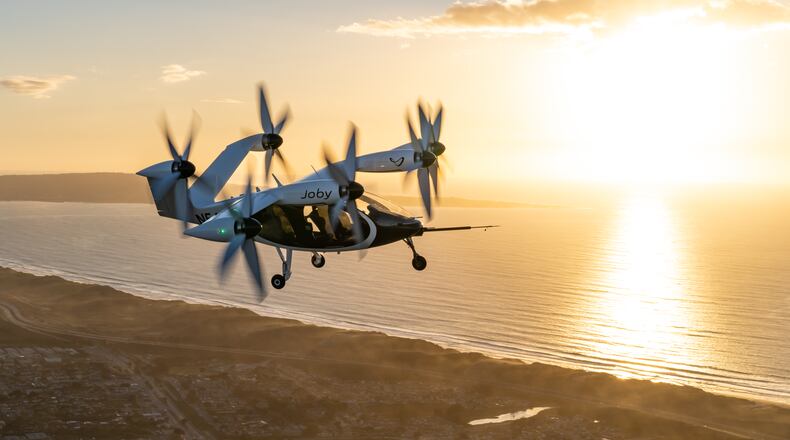It’s a future that could make flight more personal and routine, some believe, bringing quiet, zero-emissions flying to the masses — or at least closer to the masses.
It’s a future that could offer new ways to rescue downed soldiers in contested environments while offering businesses new ways to serve and connect with customers, reinvigorating more than 5,000 public, regional airports.
“The opportunities over the next decade are huge,” said Greg Bowles, head of government and regulatory affairs for Joby.
Ohio expects Joby to employ up to 2,000 people to produce these new aircraft near Dayton in a project expected to require at least $477 million in investments. The state has said up to $325 million of state and local incentives will support the effort.
Bowles encouraged those interested to check out Joby’s new Ohio hiring web site, www.jobyinohio.com.
“Congratulations to the state of Ohio for capturing the healthiest of the (eVTOL) companies that are out there,” said Sergio Cecutta, founding partner of SMG Consulting, a panel member at Tuesday’s forum.
But there are big questions to work through, not just for Joby but for the advanced air mobility industry as a whole: Finding the workers to produce these vehicles, certifying the aircraft for safe operations, securing the power needed to charge the aircraft, building the infrastructure to allow them to safely take off and land — and much more.
“We are standing up an entire eco-system,” Cecutta said. “We’re not just rolling out the airplanes. And that is quite complex.”
Air Force and military leaders have long seen the value of these types of aircraft, said Col. Elliott “Neo” Leigh, director of AFWERX and chief commercialization officer for the Air Force.
Leaders of Joby cited Air Force support and the presence of Wright-Patterson Air Force Base as key reasons for moving manufacturing to Dayton.
“Not only are they potentially game-changers, but they are probably very intuitive to operate,” Leigh said of these new aircraft, adding that he has experienced an eVTOL simulator and that it may take as little as two years to learn how to fly the vehicles.
Erik Amend, Federal Aviation Administration (FAA) regional administrator for the Great Lakes region, said the agency estimates that the first eVTOL aircraft could win FAA certification by late 2024, early 2025.
“It’s exciting to hear a date that’s not, like, 2030,” Leigh said. “We’re not dreaming anymore.”
Both Bowles and Cecutta marveled at how quiet some of these powered-lift craft are, registering at only 65 decibels to observers who are situated 100 meters away from a Joby aircraft taking off.
“When folks come to watch us fly, they whisper,” Bowles said.
“You’ve never seen an airplane you can’t hear,” Cecutta said. “It’s weird.”
David Dunning, director of global innovation and policy for the General Aviation Manufacturers Association, said manufacturers are looking for certain milestones in the next 16 months or so: Progress on certifying pilots and rules for operating these aircraft, among them.
There are myriad details to work through, such as the creation of “vertiports” for powered-lift vehicles, similar to heliports for helicopters, but with stricter noise criteria and muscular electric charging requirements.
Both Amend and Cecutta touched on the question of charging capacity.
Amend said he has spoken with administrators at an airport he did not name, saying they told him the airport did not have the power capacity at the time to accommodate eVTOL aircraft.
Cecutta said the power transformers needed to strengthen electric grids and deliver the power these aircraft need are made by only a few companies and have long lead-times between orders and deliveries.
About the Author


